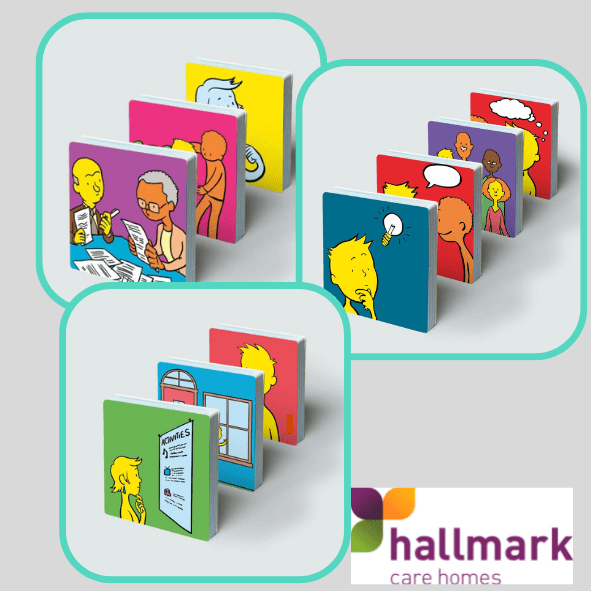
Talking Mats and Hallmark Care Home #2
In her 2nd blog April Dobson describes how Talking Mats has been implemented across Hallmark Care Homes
Many of our organisational processes across our services have become richer and more inclusive as a result of introducing Talking Mat. Here are some ways we have embedded TM within areas of our work;
- Accessible information standard; the use of TM is included as a recommendation in our organisational standard and policy
- New residents; Hallmark’s Dementia Care Managers use TM where appropriate to support people with dementia and/or communication difficulties to transition into the care home environment, and to support with care planning
- Care planning; used to gather information from the person to support their care plan
- Internal compliance monitoring and reporting; TM is part of our compliance team’s standard approach and they conduct TMs at part of every compliance audit
- Supporting people living with dementia who express unmet needs through behaviour; TM is used as part of a range of different methods to explore the reasons behind need
- To support wellbeing and lifestyles/activities choices and opportunities; TM is used by our lifestyles teams and evidence of use is required as part of our annual lifestyles audit
- Internal ‘Outstanding Pathways’ accreditation; Homes choosing to complete a Hallmark outstanding pathway in ‘resident involvement’ are required to show evidence of the use of TM in order to successfully meet the criteria (through photos, written care plans etc). This could be in connection with a planned refurbishment for example, or discussions about mealtimes etc
- Project/research evaluation; Hallmark’s Researcher in Residence includes the use of TM as part of a range of evaluation methods for all internal and external projects or research involving people living with dementia, and for those with communication difficulties. External partner researchers also receive training in the use of TM from our licensed trainer.
Since the introduction of TM, I’ve been delighted to see our trained practitioners using the resource to ‘talk’ on an individual basis about a range of topics with people living in Hallmark Care Homes, and the best way to tell you about this is to give you a few examples. I’ve used the words of our team members to describe what happened in each case. Whenever a TM is used the listener completes a short description of the mat with a photo and any actions using a template we developed. This is then included in the resident’s care plan record and reviewed regularly;
Example 1
E lives in the Residential Community and has dementia. E has a level of anxiety/distress over knowing she “lived” in a care home and becomes particularly anxious around a particular time in the evenings. She becomes flustered and can panic when she can’t communicate what she wants to say.
I used the Talking Mat to see how she felt about her time here as well as encouraging her to express herself. It helped her focus on one topic at a time and not become overwhelmed by her feelings. One theme that emerged was that E did not feel listened to by the care home team or her family. On reflection, I recalled overhearing an interaction with her son and her, where he repeatedly told E that she “lives here now” and “can’t go home”, and I remember spending time with her after this visit as it caused her so much upset. Following our work with a mat was able to share E’s opinions with the team and have been working with the family on ways to ensure E feels valued and listened to. We plan to redo the mat regularly.

.
Example 2
We did one with a new resident which I feel was very successful – it linked in to her religion and we found out that she was feeling out of touch with her faith as part of a general mat and then completed a sub mat around just this area – for example does she want a Bible in her room or visits from Jehovah Witnesses.. it was really important because actually the team got to know her through the talking mat and we had back quality time ……It’s about trust as well. She came from the hospital she was anxious and she was worried as she’d had two operations.
Example 3
.. talking mat has been an amazing tool as it enabled me to dive deeper and get to know a resident whom the team had reported that often they had a ‘hard time’ assisting with personal care needs. The Talking mat session was brilliant as the lady was able to communicate that in – fact she will not want any assistance with toileting needs as she felt she was independent. The team are now using the approach of offering their assistance rather than telling her it’s time for a wash and this has been far more successful.
Example 4
one lady just didn’t want to go to the dining room for meals so I tried a mat to find out why she would only eat in her room. We weren’t even talking about it but she kept rubbing her leg during the mat, so I quickly stopped the mat we were doing and got out some symbols showing different parts of the body. I used a different top scale to try and find out if she had pain. It turned out that she wasn’t going to the dining room as it really hurt her to walk there. I spoke to the team and they made a GP referral for pain relief which has now made a massive difference to her. I don’t think we would have picked this up without the talking mat.
For the future, we want to explore in more depth how we can use TM to support DoLS assessments, safeguarding concerns, and best interest decision making.
 Online training login
Online training login 



